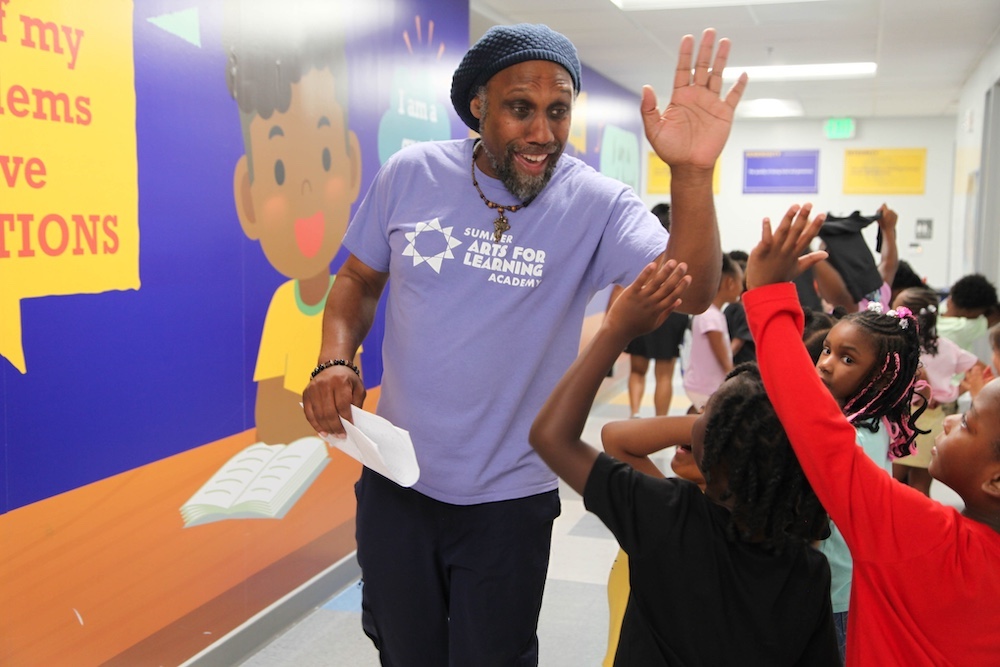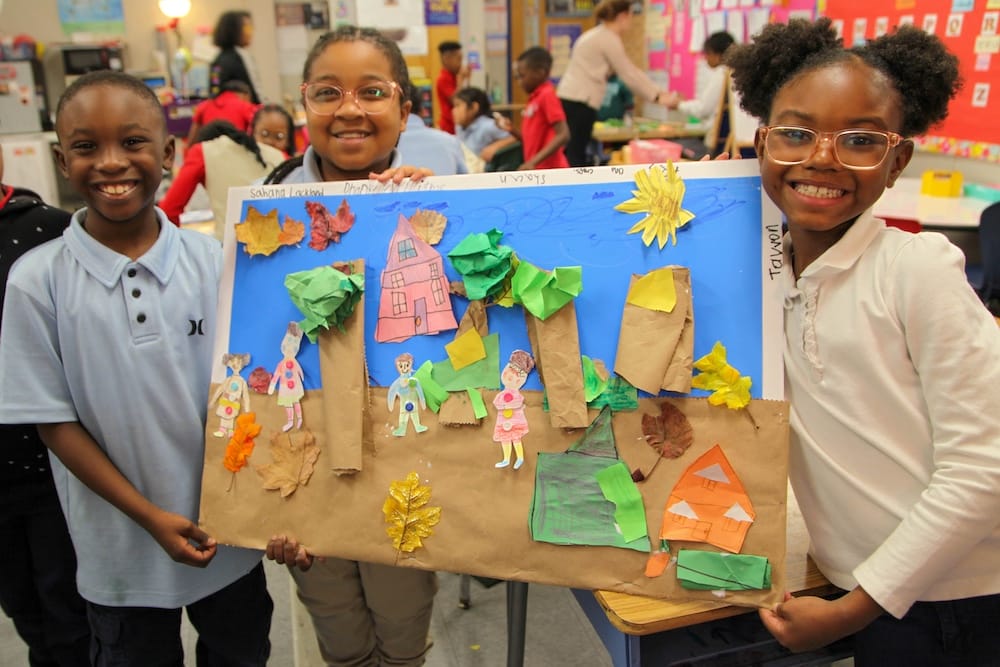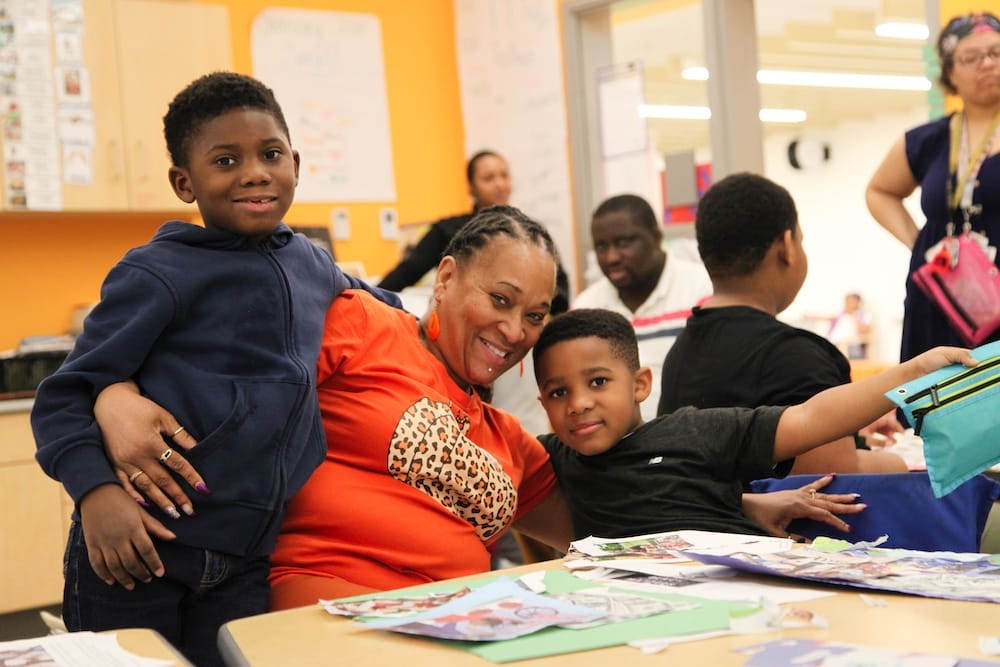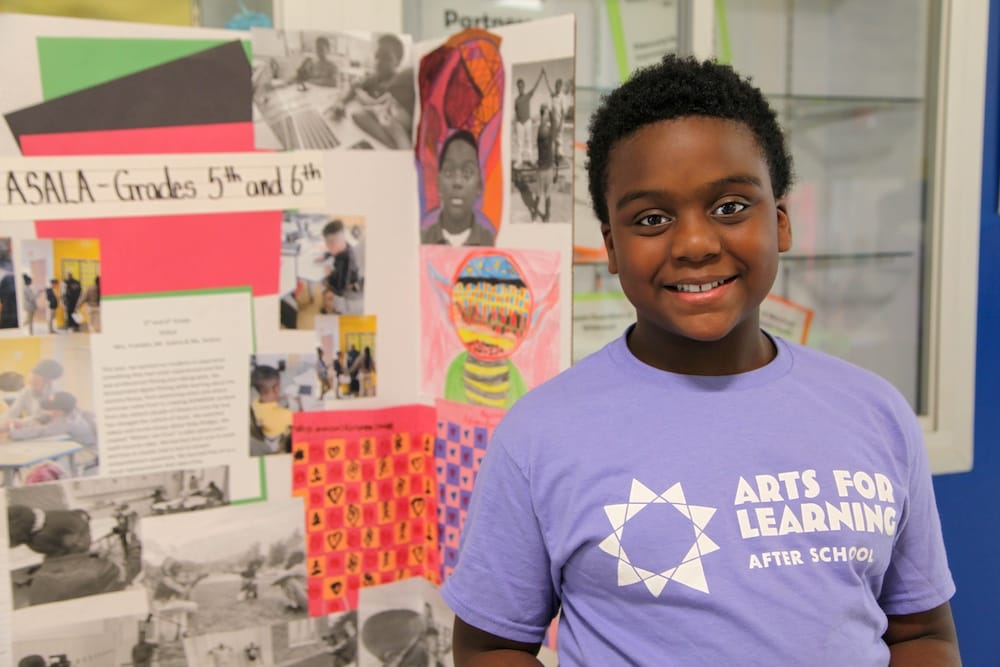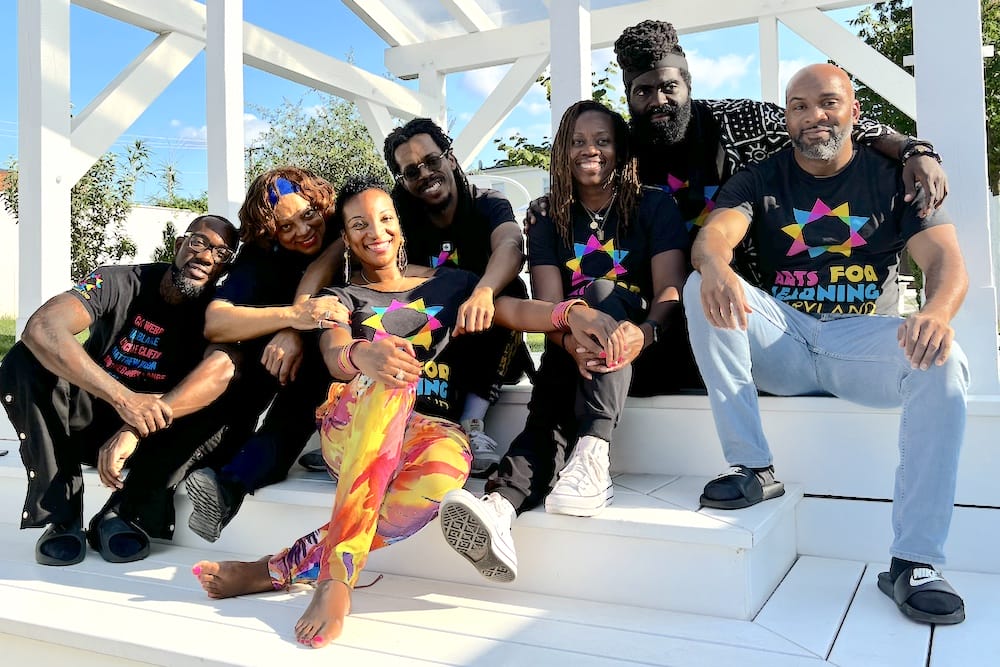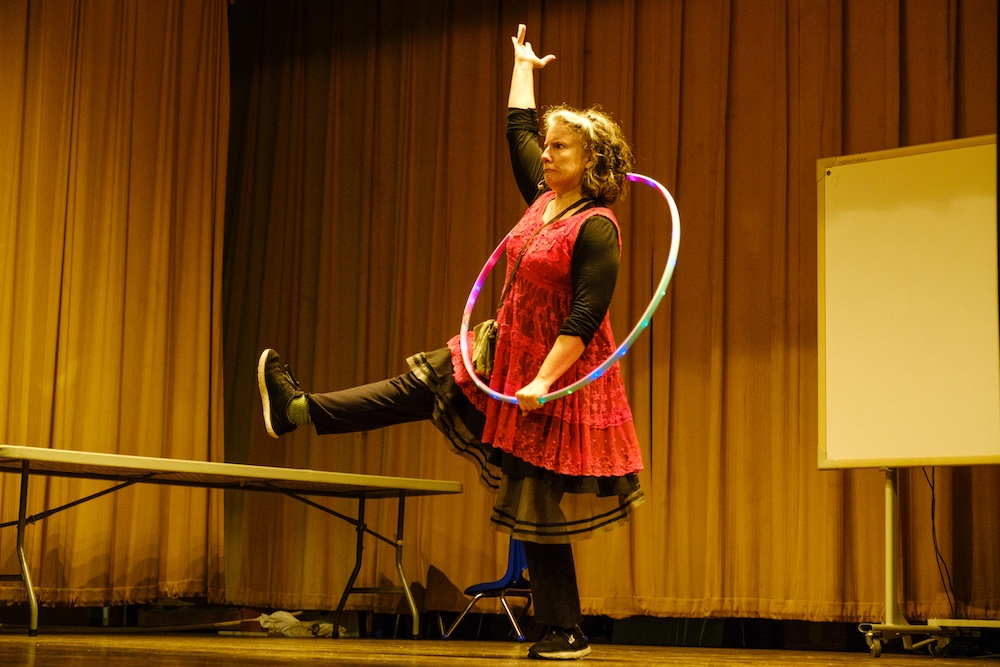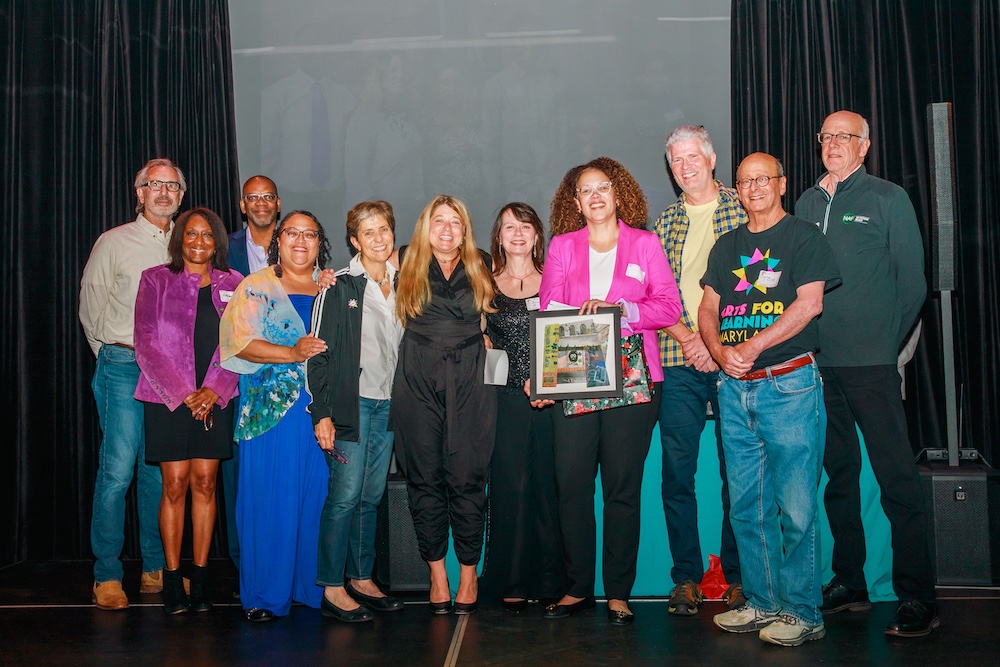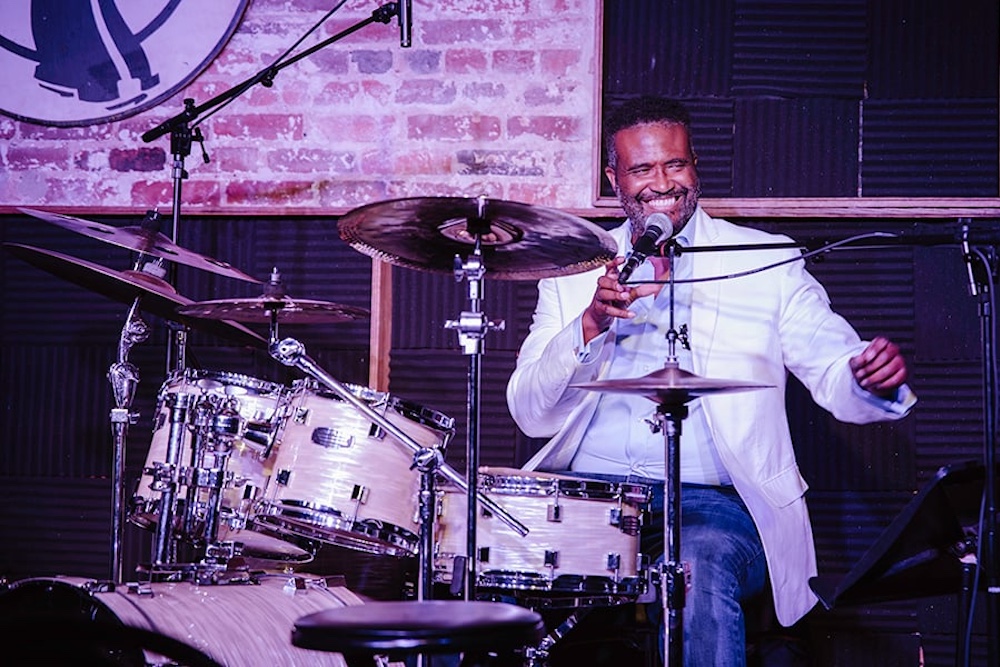Blog
SALA: It Starts with Squad
It’s hot. It’s most definitely summer. But classrooms at 13 school sites around Baltimore City are full of students who could be doing anything from practicing multiplication tables through rap, to learning sign language and singing, or creating art that encompasses a particular educational standard in the style of a famous artist.
This is Summer Arts for Learning Academy (SALA), the free, 5-week summer program for students in PreK-8th grade at Title 1 Baltimore City Public Schools. Student artwork lines the hallways and hangs on the walls of literacy and math classrooms. You might hear singing or chanting. Drumming, painting, sculpting, dancing. You see movement and collaboration. These aren’t traditional classrooms.
At SALA, students learn through arts integration, a teaching method that uses an art form as a tool to teach subjects like math, social studies, science, or literacy. Here, students don’t just explore and practice new art forms—they use them to make meaning of what they’re learning in class. That makes the content stick. It becomes theirs.
But there’s something else that makes SALA special, too.
On a summer morning at SALA at Pimlico Elementary Middle School, a young student was called for early dismissal. The student gathered their belongings, turned to the class, and waved, “Bye, everybody! I’ll see you tomorrow!”
The class did not hesitate. “Bye! See you tomorrow!”
Site Director Matthew Owens smiled at the exchange and said, “That’s Squad.”
Squad is SALA’s version of CREW or Morning Meeting, taking place at the start of each and every day. It’s during this time that the class engages in Social Emotional Learning (SEL) practice and sets the tone for the day–the space to ground every day in love and understanding.
The teachers and teaching artists at SALA cultivate community. That’s the other quality that distinguishes a SALA classroom from a traditional classroom–the something else: community. Squad creates the space for building authentic and meaningful community, and for connecting on a human level.
No matter how a student’s day has started–or a teacher, artist, or staff member’s day–when someone walks through the doors to SALA, they know they are seen. They matter.
“We pride ourselves on affirming, empowering, and inspiring our students,” Mr. Owens explained. “We make sure they have a safe and nurturing space for them to thrive.”
And it starts with Squad.
A New Classroom to Host an Expanded Cohort: The Bloomberg Arts Internship Welcomes 50 Students
Recently, Baltimore Mayor Brandon M. Scott joined students and staff in the newly completed classroom space at Arts for Learning Maryland headquarters to celebrate participants in the Bloomberg Arts Internship (BAI)–a program providing public high school students with paid internships at area arts and cultural institutions as well as professional career and college mentorship.
Mayor Scott spoke proudly of the value that BAI and similar programs, like Youthworks, contribute to the City, creating meaningful employment and learning opportunities for our young people. He joked that arts internships certainly beat his own summer employment as a teen, working in the Baltimore heat for his family’s roofing company.
The new classroom space–made possible through capital support from the Harry and Jeanette Weinberg Foundation, Abell Foundation, and France-Merrick Foundation–will host BAI this summer, as well as professional development workshops for teachers and artists throughout the year. 2025 marks the ninth year of the Bloomberg Arts Internship in Baltimore. This summer, 50 interns will be supporting arts and cultural organizations with projects ranging from marketing and community outreach, creating gallery installations, education for community programs, tackling documentation and archiving initiatives, creating props and designing sets for theatre productions, and so much more.
This year’s Bloomberg Arts Internship worksites include: AREA 405, Art with a Heart, Arts Education in Maryland Schools (AEMS), Arts Every Day, ArtsCentric, Baltimore Arts Realty Corporation, Baltimore Center Stage, Baltimore Clayworks, Baltimore Filmmakers Collective, Baltimore Improv Group, Baltimore Jewelry Center, Baltimore Museum of Art, Baltimore Rock Opera Society, Blue Light Junction, Chesapeake Shakespeare Company, Creative Alliance, Empact Art, Everyman Theatre, Johns Hopkins University Museums, Living Classrooms Ascend through Music, Maryland Art Place, Maryland Center for History & Culture, Media Rhythm Institute, National Great Blacks in Wax Museum, Peabody Preparatory, Port Discovery, Root Branch Media, Strand Theatre, Valerie J. Maynard Foundation, Walters Art Museum, WombWork Productions, and Yele LLC.
Follow BAI on Instagram to get a peek into the program, the work, and the experiences interns are engaged in this summer.
Baltimore City to Welcome Dream Academy Charter School, operated by Arts for Learning Maryland
A new charter school is coming to Baltimore City. Arts for Learning Maryland, in partnership with Thomas Jefferson Elementary/Middle School (TJEMS), will open Dream Academy Charter School for student enrollment in Fall 2026. The school will offer an arts-integrated learning model backed by ten years of consistent academic and social-emotional impact. Arts for Learning is the first new charter operator approved in ten years.
A nationally recognized nonprofit with roots in Baltimore since 1950, Arts for Learning (formerly Young Audiences of Maryland) serves students statewide with arts-integrated learning. With this new school, Arts for Learning will bring its data-driven model to life in a year-round academic setting. “We have seen this model work for students for over a decade in after-school and summer programs,” said Stacie Sanders Evans, President & CEO of Arts for Learning Maryland. “Finally, families will have the opportunity to learn this way all year round.”
Dream Academy will feature classrooms co-led by teachers and teaching artists. This unique approach, modeled for 10 years through national award-winning summer and after-school programs, has consistently improved literacy, math, attendance, and social-emotional outcomes for students, particularly those performing below grade level.
Dream Academy is not just about integrating the arts–it’s about transforming how we teach. It gives teachers the time, tools, and training to meet the diverse needs of our students. It gives students more ways to access learning, show what they know, and feel seen and successful.
TJEMS has worked with Arts for Learning since 2014, piloting arts-integrated programs. The proposal to convert the school into Dream Academy was developed in close collaboration with the community. Over 650 Baltimore families, students, educators, and artists were consulted. A 2022 survey showed overwhelming community support, with 97% of respondents agreeing that an Arts for Learning school is needed in Baltimore, and 86% indicating they would enroll their children. 90% of the TJEMS staff voted in support of the conversion.
The planned charter directly addresses critical needs outlined by Baltimore City Public Schools and the Maryland State Department of Education to address enrollment, attendance, and academic performance at TJEMS.
“Our school has real potential, and we’re ready for change,” says Adrienne Carter, parent of four TJEMS students. “Dream Academy is helping bring our vision to life. I’m proud that families and community members have a real voice, with seats on the board and [planning] events… We’re not just involved—we’re part of the Dream Team.”
The school staff share this sentiment.
“Dream Academy is not just about integrating the arts–it’s about transforming how we teach,” says TJEMS middle school teacher Dr. Yvette Freter, “It gives teachers the time, tools, and training to meet the diverse needs of our students. It gives students more ways to access learning, show what they know, and feel seen and successful.”
“It’s a dynamic academic innovation, based on research and experience, home-grown in Baltimore City for Baltimore City.”
To stay informed of enrollment details and community engagement opportunities, sign up for the Dream Academy mailing list and follow @DreamAcademy_TJEMS232 on social media.
Your Voice Matters Now More than Ever
From the desks of our President and Board Chair:
Dear Friends and Supporters,
At Arts for Learning, we believe in the power of the arts to inspire, educate, and transform lives, particularly for young people. We stand in solidarity with our colleagues at the National Endowment for the Arts (NEA) and the thousands of artists, educators, and organizations across the country who work tirelessly to strengthen our communities through creativity, cultural connection, and access to the arts.
For decades, the NEA has played a critical role in expanding opportunities for arts education and participation, particularly in under-resourced schools and communities. It has helped to ensure that every child, regardless of zip code, has the chance to learn, grow, and thrive through the arts.
The NEA has been a key partner to Arts for Learning in furthering statewide student access initiatives, like our “Rural Access for All” grants. They also support our Principal Fellowship program, which creates meaningful opportunities for Maryland principals to develop action plans that utilize the arts for school-wide improvements.
But today, that legacy is uncertain.
On Friday, the federal government announced an immediate revocation of grant dollars and dramatic cuts to federal funding that support vital artistic programs. Additionally, the proposed federal budget for 2026 eliminates the NEA entirely. These cuts will jeopardize the future of countless initiatives in our community and across our nation, including our own. Our young people will be most impacted by these decisions.
Your voice matters now more than ever. The national arts advocacy group Americans for the Arts is asking folks to:
- Contact your elected officials
- Complete a national survey (organizations + grantees)
- Share your story
Visit Americans For The Arts
We believe that every child deserves access to the life-changing power of the arts. With your help, we can ensure they continue to have that chance—this summer and for generations to come.
With gratitude and resolve,
Stacie Evans, President and CEO, Arts for Learning Maryland and Sheelagh Allston, Board Chair, Arts for Learning Maryland
Family Engagement Nights at Your School
Does your school community need more family engagement? Partner with A4L to plan a dynamic family-focused evening of fun centered around a relevant curriculum area! Families will enjoy an easy-to-follow arts-infused demo lesson led by trained teaching artists. With dozens of programs to choose from, families might practice conflict resolution through improv theatre, explore environmental science through recycled instrument making, or even financial literacy through a musical! Parents take away effective, creative approaches to supporting student growth at home while having a blast and building community!
“The kids had so much fun and families had great feedback.”
–Teacher, Mary Ann Winterling Elementary
“I loved seeing the students clapping out the syllables and going back to their papers because their idea fit.”
–Literacy Coach, Harlem Park Elementary/Middle
Book a Family Engagement Night for your students by emailing k12programs@artsforlearningmd.org
Abrupt Federal Cuts to After School Programs: Our Response
Dear Friends and Supporters,
On Friday, we learned that–due to the US Department of Education’s decision to renege on previously approved pandemic-recovery funding–Baltimore City Schools was forced to abruptly cancel our After School Arts for Learning Academy (ASALA) at five schools. In addition to ASALA, 11 other after-school and tutoring programs, serving 65 schools across the city were canceled.
Thousands of students and families will be impacted.
Baltimore City Schools is as pained about this occurrence as we are. As the Baltimore Banner reports, the Federal Government is not just ending pandemic-recovery funding; they are refusing to reimburse school districts in Maryland for funds already spent or contractually committed. This places Baltimore City Schools immediately in $48 MILLION of debt.
Cutting ASALA before the end of the school year will impact 539 students who benefit from the academic support. For us, this is particularly painful because our data clearly show how remarkable ASALA has been in reversing COVID learning loss for students who participate.
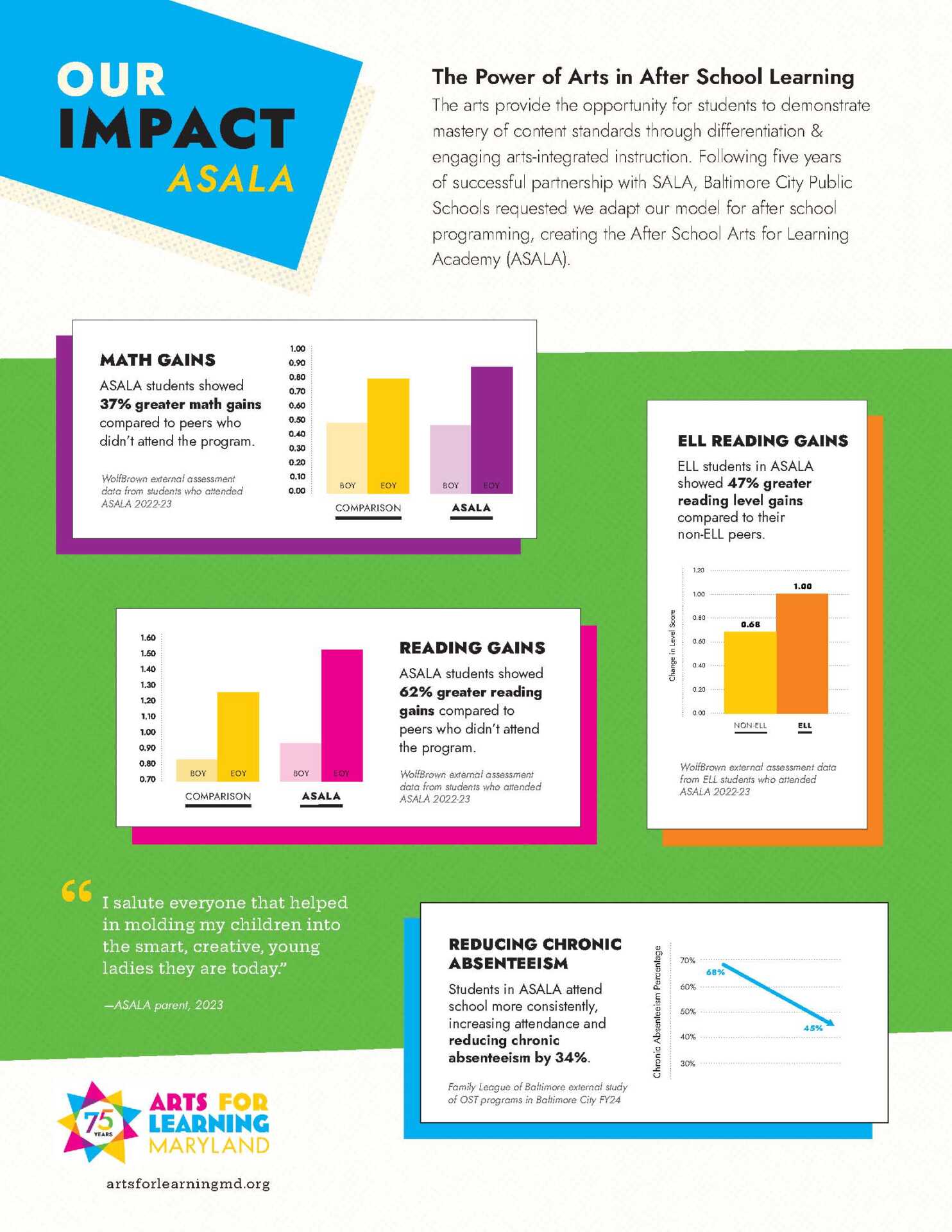
ASALA families depend on safe, engaging out-of-school-time care and educators and teaching artists rely on this work to pay their bills. For all of these reasons, and despite awareness that these cuts may be just the beginning of what may be coming down the pike, we have decided to use our own reserve funds to continue ASALA through mid-May.
A4L’s Board Executive Committee met Sunday to approve the continuation of a scaled-back program at the impacted sites: Arundel, Dorothy I. Height, Glenmount, Sinclair Lane, and Wildwood.
We are exploring how we can partner with impacted families, staff, and fellow after-school and nonprofit providers to raise awareness about how this Federal action is harming our community.
As always, Arts for Learning remains committed to Maryland students, artists, educators, and families. Our work is strengthened by our passionate community.
Stacie Sanders Evans, President & CEO
A message from our CEO…
This letter reaches you at a time when many things happening in our country threaten the work Arts for Learning does, how we do it, who has access to our programs, and in many cases, the people in our community.
Our commitment:
We at A4L remain vested in our commitment to serving children, fostering communities, and changing education. We do this through dedication, caring, and love—ensuring all in our community feel seen and valued, regardless of wealth, skin color, background, ability, sexual orientation, or gender identity. We remain, and will always be, committed to these principles. We hold them tight as we listen and learn from our folks on the ground doing the work in communities.
How at risk are the people we serve?
A4L impacts over 150,000 students annually, employing 60 full-time staff, and over 400 contractual teaching artists and educators. Much of our funding comes either directly or indirectly (through school contracts) from Federal grants. The recently proposed cuts to government funding and the dismantling of the US Dept of Education would dramatically affect our ability to serve Maryland students, particularly students in high-poverty communities. We rely on these funds to deliver award-winning, data-driven programs that support academic achievement through the arts, such as the Arts for Learning Academies (SALA and ASALA).
What do we know?
The arts transform lives, classroom learning, and student outcomes. We have evidence to back this up. This is because the arts foster creativity, connection, self-expression, understanding, and a greater sense of belonging for our young people. We need more of this in our world right now–not less. (see why)
What are we doing?
In response to executive orders threatening immigrants, we are arming staff and artists with information so they are better prepared to protect their rights and the rights of our students. Next week, we will bring together artists working with children impacted by the threat of ICE, to understand clearly how we can support teachers, principals, and their students.
Despite executive orders promoting an anti-DEI agenda, we continue to support artists and teachers to create classrooms grounded in identity, belonging, and love that celebrate the diversity of the communities we serve. We provide and participate in trainings that equip us to support our diverse community, including Black and brown communities and the LGBTQ+ community. After a significant decline in corporate sponsorships threatened our annual Blacktastic! A Virtual Festival of Maryland Black History + Culture–our board of directors stepped in to replace corporate dollars with their own, and found new sponsors with the courage to fill the gap. With their help, over 48,000 Maryland children are able to attend this festival next week.
Under threat of losing federal funding, we have committed to stay the course–finding alternate forms of funding to ensure artists remain employed, young people have equitable access to the arts, and schools can depend on us to enrich teaching and learning. This threat includes a four-year, $3.9M federally funded research grant for the largest data collection and evaluation of an arts integration intervention in our country’s history. Regardless of executive action, we will complete at least the third year. These findings could help shape the future of education.
How can you help? Learn what you can do now.
Thank you for the dedication and love you all share with us,
Stacie Sanders Evans, President & CEO
Blacktastic! 2025 – Black History Month Content like no other
This February, the fifth annual Blacktastic! returns, bigger and better than ever!
Looking for joyful, original, and exciting Black History Month programming? Join us in celebrating the joy of Maryland’s Black history and culture through Blacktastic! This extended virtual program features Arts for Learning’s teaching artists, enriching and developmentally appropriate virtual performances, trivia, and exciting virtual field trips to historic sites that honor Blacktastic leaders from our marvelous State of Maryland. Our biggest virtual event, over 56,000 students registered to take part in Blacktastic in 2024!
One recent participant shared: “Blacktastic. It’s not a word. It’s a feeling, a celebration—a close encounter with the work of some very dedicated artists who bring their work through the computer to your classroom. This festival was an amazing opportunity for students and teachers alike to experience the power of the arts—a variety of forms and contents, all in one. Can’t wait to see where this goes next year!”
This February’s honorees include abolitionist Harriet Tubman; author and minister Josiah Henson; current creative director at Mattel Studios, Sidney Clifton; and pioneering trade union leader Isaac Myers and more, brought to you by our talented Arts for Learning teaching artists and some special local guests. Featured Arts for Learning teaching artists for 2025: Debra Mims, Baba Bomani, Jamaal “Mr. Root” Collier, Quynn Johnson, Drew Anderson, Tyronda Boone, Dr. David Fakunle and Jessica “Culture Queen” Smith.
NEW this year!
You asked for content tailored to the students you teach. This year, Blacktastic will be split into two days. Wednesday, February 26 will include content for elementary school students and Thursday, February 27 will feature content for students in middle and high school.
All on a new and improved user-friendly streaming platform!
The best part? You don’t have to pay anything additional. Registration includes live access to both days of programming, a curriculum-aligned activity book to lock in the learning, and extended access to revisit the programs—through June 30, 2024!
Experience Maryland’s Black History with this program like no other! Register your school or classroom today on our website at artsforlearningmd.org/blacktastic!
Arts for Learning Maryland Selected to Join Bloomberg Philanthropies Digital Accelerator Program
Arts for Learning will join a cohort of 200 nonprofit cultural organizations from across the U.S. and U.K. to improve essential digital infrastructure.
Today, Arts for Learning announced that it has been selected to join the Bloomberg Philanthropies Digital Accelerator Program. This initiative helps cultural organizations across the U.S. and U.K. to strengthen technology and management practices to improve operations, drive revenue, increase fundraising, engage broader audiences, and deliver dynamic programming.
“Joining the Bloomberg Philanthropies Digital Accelerator Program is an incredible opportunity for Arts for Learning to reimagine how we connect with our audiences and partners,” says Arts for Learning CEO, Stacie Sanders Evans. “Strengthening our digital infrastructure will not only help us streamline operations through improved digital tools and systems but also allow us to reach more students, educators, and communities with the transformative power of the arts.”
Over the past three years, the Digital Accelerator Program has been a catalyst for strengthening nearly 150 cultural organizations across the U.S. and U.K. To date, the 40 institutions that were part of the first cohort cumulatively grew an additional $20 million in new revenue–including through fundraising–, reached over 1 million new audience members, and engaged more than 4,000 new artists and partners.
Arts for Learning is one of 200 nonprofit cultural organizations accepted into Bloomberg Philanthropies’ new Digital Accelerator Program cohort, spanning artistic disciplines and organization size in 52 U.S. cities and 28 U.K. cities.
Bloomberg Philanthropies invests in 700 cities and 150 countries around the world to ensure better, longer lives for the greatest number of people. The organization focuses on creating lasting change in five key areas: the Arts, Education, Environment, Government Innovation, and Public Health. Bloomberg Philanthropies encompasses all of Michael R. Bloomberg’s giving, including his foundation, corporate, and personal philanthropy as well as Bloomberg Associates, a philanthropic consultancy that advises cities around the world. In 2023, Bloomberg Philanthropies distributed $3 billion. For more information, please visit bloomberg.org.
Teaching Artist Profile: Michele Minnick
Arts-integrated learning is incredibly moving for students. In theatre artist Michele Minnick’s programs, we mean that literally! As an Arts for Learning teaching artist for more than six years, Michele provides arts-integrated experiences in a variety of subjects through a simple yet powerful idea: movement.
“When students engage with their bodies and emotions, it gets their brains going,” she explains. “They become more open and able to engage with the ideas. It also stimulates social emotional learning, which is essential for students in and beyond the classroom.”
In her classroom programs, Michele collaborates with teachers to craft a creative, movement-based experience that relates to the curriculum and resonates with students through the many elements of theatre. Students learn to depict emotions such as anger, fear, love, surprise, and courage by creating shapes and tableaus with their bodies.
While exploring the science of bees, a 2nd-grade class at Lakeland Elementary in West Baltimore got on their feet and imitated the movement (and emotions!) of bees to enhance their study of pollination–all led by one of Michele’s invented characters, Ms. Buzziworth! In another class, Michele guided third graders as they performed a play based on the book How Many Days–a story of immigrants coming to the United States on a boat. In the process, students saw how text can be adapted for theatrical purposes while improving their reading fluency in the process.
One look into a classroom where Michele is working illustrates the impact: students cry out with delight when she arrives. “I regularly see typically shy students come out of their shells and participate. Their joy, enthusiasm, and excitement about making discoveries is so infectious and fulfilling.”
That joy and curiosity inspires Michele’s work outside of the classroom, where she works as a curator, director, educator, and performer. Most recently, Michele has incorporated that influence into Vital Matters, an interdisciplinary laboratory for change that produces arts-based events addressing climate and environmental justice. Vital Matters directly relates to her work in the classroom.
The central emotional tone of Michele’s work is joy, vitality, and connection. When engaging in topics like climate, or science lessons in the classroom through creative practice, it opens the heart. It surprises participants–old or young–at how fun and joyful the process can be–even with serious topics. That’s what creativity can do!
View Michele’s Program Offerings
Celebrating Stacie Sanders Evans’ 20 Years at the Helm
Twenty years ago, Arts for Learning Maryland (then Young Audiences of Maryland) looked and felt a lot like it did when it was founded in 1950. A staff of four was focused on booking artists for predominantly school assemblies, mostly in the Baltimore area.
Then Stacie Sanders Evans was hired as president & CEO.
In her two inspiring decades leading Arts for Learning (A4L), Stacie’s passion and commitment to arts integration has resulted in a dramatic transformation. Today, more than 155,000 students a year participate in A4L’s artist-led programs across Maryland. A 60+ person staff creates innovative and nationally modeled initiatives. 190 teaching artists are contracted each year to inspire students to create, learn, and find joy–bringing over $3M of paid opportunities for artists in Maryland. Over 10,000 educators are impacted, through professional development and arts-integrated programs.
Stacie leads with joy, a deep commitment to the arts in education, and a steadfast belief in its transformative impact on student learning. She inspires everyone around her to go for it, to try new things, and to push innovative strategies and engaging programs.
Last month, staff, board, partners, artists, and friends surprised Stacie with an anniversary celebration at Creative Alliance in South Baltimore. Everyone had an absolute blast honoring Stacie and returning the enthusiasm that she showers on each of us! See for yourself in the photos.
Congratulations and thank you, Stacie!
Teaching Artist Profile: Vinton Jones
We’ve heard it many times: to understand the world today, we must understand what came before. For students of Arts for Learning teaching artist Vinton “The Music Man” Jones, that means using what they learn about the history of music to inspire and explore their own creativity!
Vinton Jones is a professional drummer and soul singer who has toured with the likes of Jean Carne and Shirley Jones, as well as his group, The Vinton Jones Vibration. He is also a music teacher at J. Frank Dent Elementary in Prince George’s County. He has been engaging students in music-based learning for over 20+ years.
“Music is everything; it’s math, it’s science, it’s history,” says Vinton. “There’s nothing it doesn’t impact. With music, you’re experimenting and practicing trial and error and decision-making. You’re learning to relate to others–their interests or their styles of playing.”
Vinton’s love for music goes back to when he was only a few years old.
“I first found music in church,” explains Vinton. “Sitting in that first pew and seeing that drum set, I knew I needed to get one for myself. Once I did, I never looked back – I fell in love with music. I try to bring that–the joy, history, and possibilities of music–in my work with students.”
That love shines brightly in Vinton’s Arts for Learning Maryland program–Jazz to Hip-Hop. This music-packed assembly (featuring Vinton on drums) explores the deep connections between the two music genres and illustrates how jazz serves as a foundation for hip-hop.
“Many students love hip hop but have no idea about the connection to jazz,” says Vinton. “From improvisation’s progression to rap battles, snippets of jazz tunes used as samples on hip hop tracks, or skatting compared to beat-boxing, the connections are everywhere. At first, they might be hesitant. But soon, they see and hear it, and the lightbulb goes off. Jazz is our music.”
Through this assembly, students understand what music is and what it can be. They’re diving into jazz, which Jones calls the “classical music of America.” By learning about these genres, students are expanding the palette of their creativity. They’re generating ideas, inspirations, and aspirations of what they could create. And like with all art forms, the lessons in music extend to life in general.
“I tell my students. If you love something and want to do something, why not learn everything you can about it? It’s about going for it. Creativity is what made the cell phone; the first automobile. You need creativity to come up with things we’ve never seen before. I ask students; what’s the next thing you’re going to create?”









